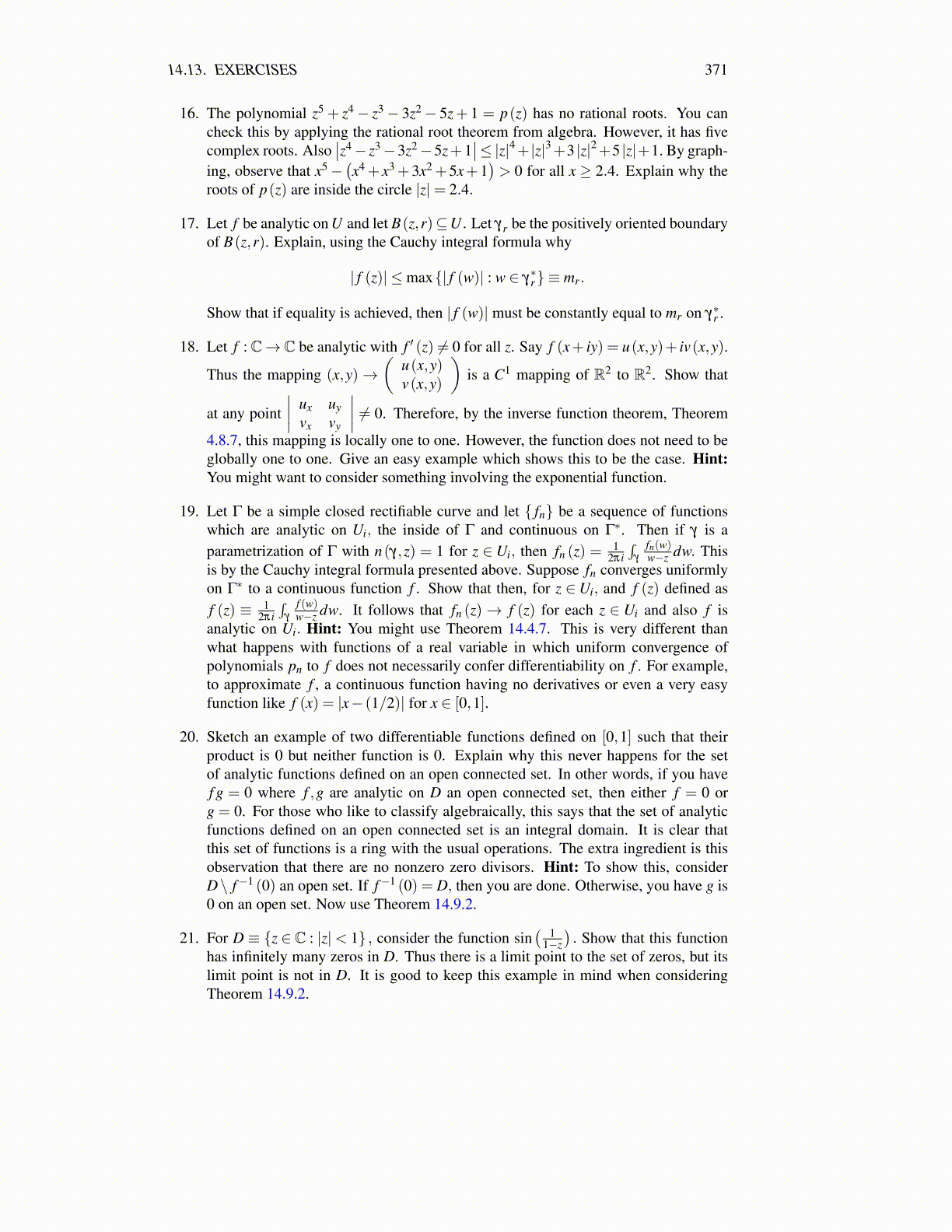
14.13. EXERCISES 371
16. The polynomial z5 + z4− z3− 3z2− 5z+ 1 = p(z) has no rational roots. You cancheck this by applying the rational root theorem from algebra. However, it has fivecomplex roots. Also
∣∣z4− z3−3z2−5z+1∣∣≤ |z|4+ |z|3+3 |z|2+5 |z|+1. By graph-
ing, observe that x5−(x4 + x3 +3x2 +5x+1
)> 0 for all x ≥ 2.4. Explain why the
roots of p(z) are inside the circle |z|= 2.4.
17. Let f be analytic on U and let B(z,r)⊆U . Let γr be the positively oriented boundaryof B(z,r). Explain, using the Cauchy integral formula why
| f (z)| ≤max{| f (w)| : w ∈ γ∗r} ≡ mr.
Show that if equality is achieved, then | f (w)| must be constantly equal to mr on γ∗r .
18. Let f :C→C be analytic with f ′ (z) ̸= 0 for all z. Say f (x+ iy) = u(x,y)+ iv(x,y).
Thus the mapping (x,y)→(
u(x,y)v(x,y)
)is a C1 mapping of R2 to R2. Show that
at any point∣∣∣∣ ux uy
vx vy
∣∣∣∣ ̸= 0. Therefore, by the inverse function theorem, Theorem
4.8.7, this mapping is locally one to one. However, the function does not need to beglobally one to one. Give an easy example which shows this to be the case. Hint:You might want to consider something involving the exponential function.
19. Let Γ be a simple closed rectifiable curve and let { fn} be a sequence of functionswhich are analytic on Ui, the inside of Γ and continuous on Γ∗. Then if γ is aparametrization of Γ with n(γ,z) = 1 for z ∈ Ui, then fn (z) = 1
2πi∫
γ
fn(w)w−z dw. This
is by the Cauchy integral formula presented above. Suppose fn converges uniformlyon Γ∗ to a continuous function f . Show that then, for z ∈Ui, and f (z) defined asf (z) ≡ 1
2πi∫
γ
f (w)w−z dw. It follows that fn (z)→ f (z) for each z ∈ Ui and also f is
analytic on Ui. Hint: You might use Theorem 14.4.7. This is very different thanwhat happens with functions of a real variable in which uniform convergence ofpolynomials pn to f does not necessarily confer differentiability on f . For example,to approximate f , a continuous function having no derivatives or even a very easyfunction like f (x) = |x− (1/2)| for x ∈ [0,1].
20. Sketch an example of two differentiable functions defined on [0,1] such that theirproduct is 0 but neither function is 0. Explain why this never happens for the setof analytic functions defined on an open connected set. In other words, if you havef g = 0 where f ,g are analytic on D an open connected set, then either f = 0 org = 0. For those who like to classify algebraically, this says that the set of analyticfunctions defined on an open connected set is an integral domain. It is clear thatthis set of functions is a ring with the usual operations. The extra ingredient is thisobservation that there are no nonzero zero divisors. Hint: To show this, considerD\ f−1 (0) an open set. If f−1 (0) = D, then you are done. Otherwise, you have g is0 on an open set. Now use Theorem 14.9.2.
21. For D ≡ {z ∈ C : |z|< 1} , consider the function sin( 1
1−z
). Show that this function
has infinitely many zeros in D. Thus there is a limit point to the set of zeros, but itslimit point is not in D. It is good to keep this example in mind when consideringTheorem 14.9.2.